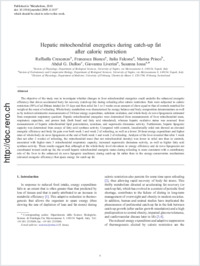Hepatic mitochondrial energetics during catch-up fat after caloric restriction
- Crescenzo, Raffaella Section of Physiology, Department of Biological Sciences, University of Naples, Italy
- Bianco, Francesca Section of Physiology, Department of Biological Sciences, University of Naples, Italy
- Falcone, Italia Section of Physiology, Department of Biological Sciences, University of Naples, Italy
- Prisco, Marina Section of Evolutionary and Comparative Biology, Department of Biological Sciences, University of Naples, Italy
- Dulloo, Abdul G. Division of Physiology, Department of Medicine, University of Fribourg, Switzerland
- Liverini, Giovanna Section of Physiology, Department of Biological Sciences, University of Naples, Italy
- Iossa, Susanna Section of Physiology, Department of Biological Sciences, University of Naples, Italy
-
04.01.2010
Published in:
- Metabolism. - 2010, vol. 59, no. 8, p. 1221-1230
English
The objective of the study was to investigate whether changes in liver mitochondrial energetics could underlie the enhanced energetic efficiency that drives accelerated body fat recovery (catch-up fat) during refeeding after caloric restriction. Rats were subjected to caloric restriction (50% of ad libitum intake) for 15 days and then refed for 1 or 2 weeks on an amount of chow equal to that of controls matched for weight at the onset of refeeding. Whole-body metabolism was characterized by energy balance and body composition determinations as well as by indirect calorimetric measurements of 24-hour energy expenditure, substrate oxidation, and whole-body de novo lipogenesis estimated from nonprotein respiratory quotient. Hepatic mitochondrial energetics were determined from measurements of liver mitochondrial mass, respiratory capacities, and proton leak (both basal and fatty acid stimulated), whereas hepatic oxidative status was assessed from measurements of hepatic mitochondrial lipid peroxidation, aconitase, and superoxide dismutase activity. Furthermore, hepatic lipogenic capacity was determined from assays of fatty acid synthase activity. Compared with controls, isocalorically refed rats showed an elevated energetic efficiency and body fat gain over both week 1 and week 2 of refeeding, as well as a lower 24-hour energy expenditure and higher rates of whole-body de novo lipogenesis at the end of both week 1 and week 2 of refeeding. Analysis of the liver revealed that after 1 week (but not after 2 weeks) of refeeding, the mitochondrial mass (but not mitochondrial density) was lower in refed rats than in controls, associated with higher state 3 mitochondrial respiratory capacity, increased superoxide dismutase activity, as well as higher fatty acid synthase activity. These results suggest that, although at the whole-body level elevations in energy efficiency and de novo lipogenesis are coordinated toward catch-up fat, the overall hepatic mitochondrial energetic status during refeeding is more consistent with a contributory role of the liver in the enhanced de novo lipogenic machinery during catch-up fat rather than in the energy-conservation mechanisms (elevated energetic efficiency) that spare energy for catch-up fat.
- Faculty
- Faculté des sciences et de médecine
- Department
- Département de Médecine
- Language
-
- English
- Classification
- Biological sciences
- License
-
License undefined
- Identifiers
-
- RERO DOC 17280
- DOI 10.1016/j.metabol.2009.11.015
- Persistent URL
- https://folia.unifr.ch/unifr/documents/301435
Statistics
Document views: 144
File downloads:
- pdf: 229
